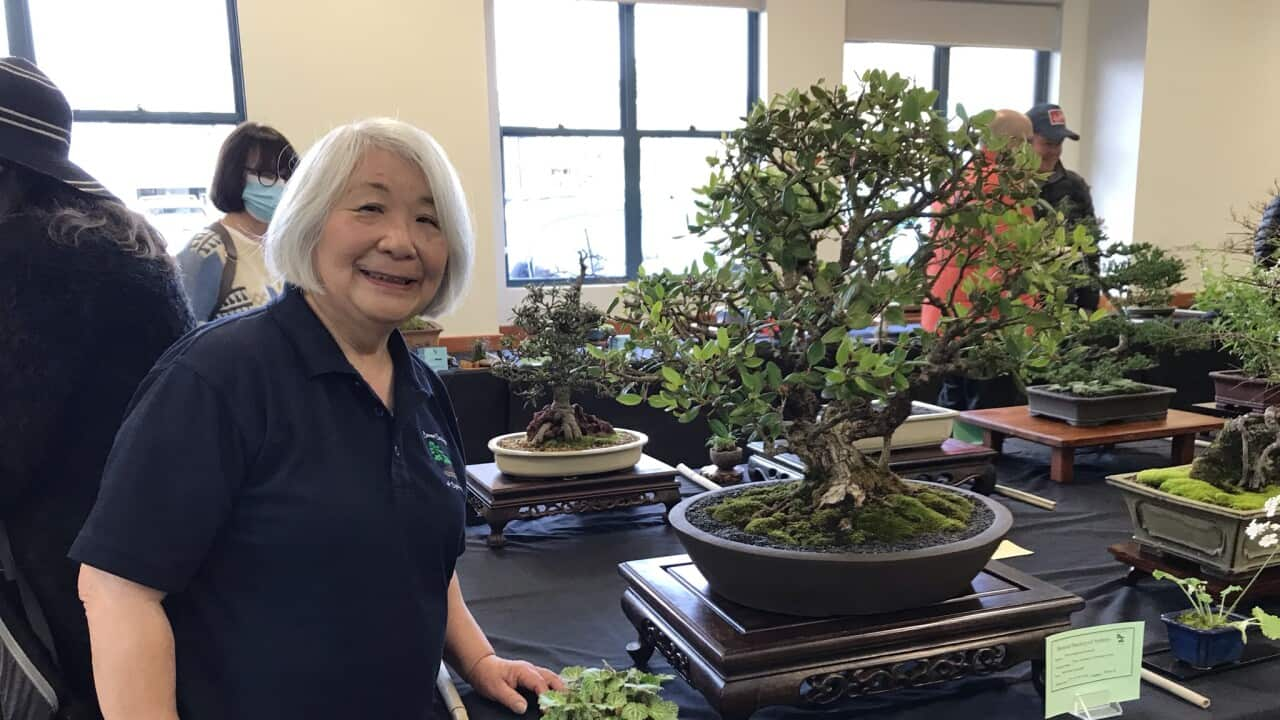Key Points
- Megumi Bennett is a bonsai master who came to Australia from Japan when she was 28 in 1974
- As founder of the Bonsai Society of Sydney, Mrs Bennett is passionate about incorporating Australian plants into the age-old Japanese artform
- She says caring for a bonsai is like caring for your own child
When Mrs Bennett came to Australia in 1974 as a 28-year-old, she hoped to study the local flora in order to put a unique twist on the Japanese art forms of bonsai and ikebana.
After completing a three-year horticulture course at Ryde School of Horticulture, where she also taught bonsai, Mrs Bennett opened a bonsai nursery in Terrey Hills, Northern Sydney, in 1988.
Mrs Bennett then founded the Bonsai Society of Sydney in 1999. In all, she has been a bonsai expert for more than 45 years.

Japanese bonsai featuring Australian fig tree at the 2022 Bonsai Exhibition by the Bonsai Society of Sydney. Credit: SBS
Compared to potted flowers, bonsai need far more commitment and it can take years for a tree to start showing its shape, individual characteristics and beauty.
In recent times bonsai has become a global phenomenon. The World Bonsai Convention, started in 1989, is held every four years in different corners of the world just like the Olympic Games.
At the eighth convention held in 2017 in Saitama, Japan, about 60 per cent of the 1,200 exhibitors were from outside Japan.
This year, the 9th World Bonsai Convention will be showcased online from Perth, WA, kicking off on 8 October and running for nine days.
Australian bonsai
Mrs Bennett's interest in migrating Down Under stems from a book sent to her by an Australian high-school art teacher that detailed native flowers.
She describes it as a life-changing moment.
“I saw flowers I hadn’t seen before [in the book]. I got the urge to go to Australia and try Japanese ikebana with Australian flowers,” Mrs Bennett tells SBS Japanese.
She started learning ikebana, Japanese flower arrangement, when she was in Year 7 and obtained a teaching certificate for it when she was a first-year student at university.
Mrs Bennett applied for a one-year business visa for the purpose of teaching ikebana in Australia.
“The [sad] thing about ikebana is that your work doesn’t last. What’s left in your hands [after years] are only photos. I wanted my work to stay longer with me. That’s one of the reasons why I shifted my focus more towards bonsai,” Mrs Bennett says.

Japanese bonsai master Megumi Bennett giving a lecture. Credit: Bonsai Art Pty Ltd
Her passion for creating a uniquely Australian version of bonsai has led her to conduct extensive research into native fig trees.
In 2018, Mrs Bennett and her son Alex, also a bonsai expert, held a bonsai exhibition featuring Australian fig trees in Sydney.
“In general, Australian trees are happy as long as you give them plenty of water. If something is wrong, it’s often an issue with water. They are drier and tougher than Japanese trees, so it is difficult for you to arrange the shape by using wires,” Mrs Bennett says.
Each tree is different. Fig trees, you can see personality there. Look at their aerial roots.Megumi Bennett
According to Mrs Bennett, the fig tree species that are best for bonsai are the Port Jackson fig and small-leaved fig as their leaves grow smaller and denser over time.
Both are found in parks in Sydney.
She also made bonsai with the Creek Sandpaper fig, Moreton Bay fig, and even tropical fig trees in Queensland.
"If I pick one fig tree which is attractive as a bonsai, it would be large-leaved weeping fig.
"This tree doesn't grow tall, so you are allowed to plant it in your yard. They bear lots of small fruits and the branches droop with the fruits. It's unique, good for a bonsai."
Like caring for your own child
If you start your bonsai from a seed, it takes up to 10 years to see its “grown-up” shape. Bonsai need daily personalised care, including watering a few times a day, regular pruning, humidity and temperature control, and pot changing as it grows.
Mrs Bennett says it’s not uncommon for people to treat their bonsai as if it is their own child or a family member.

Credit: Bonsai Art Pty Ltd
“When you start from a seed, it’s exciting to see how it grows, it’s a great joy to see it," Mrs Bennett says.
After many years, your bonsai is not a 'child’ anymore, now it’s your turn to learn from them. You learn a lot from older bonsai.Megumi Bennett
The comparison to a family member doesn't end there.
“Showing your bonsai at an exhibition makes you as nervous as if your child is on stage or something. I don’t really sell my bonsai collection much, but when I do let go of it, it’s not easy at all,” Mrs Bennett adds.

Credit: Bonsai Art Pty Ltd
“Part of me doesn’t want to keep the bonsai only to myself. If it’s a good bonsai, it’s nice to be seen and appreciated by other people,” she says with a smile.
“The buyer agreed to have the bonsai checked by me twice a year for maintenance. I can live with that.”
The Bonsai Society of Sydney will hold a bonsai exhibition at the Calyx at the Royal Botanic Garden, Sydney, from 9-11 September.








